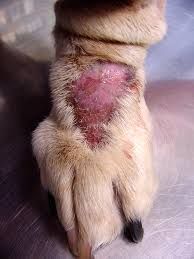
OCD
Canine Obsessive-Compulsive Disorder
Excessive licking, sucking, snapping and running in circles - what's going on?
Posted August 7, 2016

Obsessive-compulsive disorder (OCD) affects some 1-3 percent of the human population and for some can be severely debilitating. It would be highly surprising, according to the tenets of “one medicine,” if it did not also occur in animals and, of course, it does. Read on to find out more!
The first revelation that animals have OCD was made by Dr. Judith Rapoport, a child psychiatrist at the National Institute of Mental Health. She wrote a book about a boy with OCD – The Boy Who Couldn’t Stop Washing - and following a national media tour was inundated with messages saying, “My dog does that, too.” The dogs referred to were compulsively licking the lower extremities of their limbs, so-called acral lick, and on the surface it did look a lot like canine “hand” washing.
Smart woman that she is, Dr. Rapoport did not dismiss this suggestion but rather decided to research the possibility. She did this most elegantly by demonstrating that dogs with acral lick respond almost identically to serotonin-enhancing drugs like Prozac and Zoloft. So validated, the “animal model” of OCD was widely touted in the 1990s and completely changed the veterinary perspective on this and other repetitive behavior disorders.
Although some take exception to saying that animals can have obsessions (constantly recurring thoughts) because their thought processes are, let say, difficult to assess though fMRI is beginning to reveal some aspects of animal thinking. Purists (a.k.a. extreme behaviorists) would prefer I used the more cautious tag of Canine Compulsive Disorder (CCD). In people, compulsions can occur without preceding obsessions so, even if we are simply talking about compulsions, the debate is largely academic.
Acral lick, the first established canine OCD, involves dogs repetitively licking either a wrist (carpus), the top of their paw (metacarpus), or the equivalent locations on the rear legs. Any one dog can have more than one favorite lick location. If physically prevented from licking one location by, for example, encasing the lower limb in a fiber cast, the dog often simply shifts its relentless drive to lick to a different location.
All compulsive disorders in humans and animals derived from species typical, hard-wired behaviors necessary for the survival of the species. Dogs are diggers, predators and groomers, to name but a few of their species-typical behaviors, and canine compulsive behaviors, when they arise, express as repetitive versions of these behaviors in excess and out of context.
Acral lick, like other canine OCDs may result in physical injury. The continuous licking first denudes the skin of hair coat, then causes local inflammation followed by ulceration and secondary infection. One of the most severe cases I ever saw resulted in refractory osteomyelitis of the underlying bone necessitation amputation of the dog’s limb.
Veterinarians have tried treating acral lick with various salves and potions, including corticosteroids, antibiotics and analgesic. Antibiotics are helpful to treat secondary infection but have no primary action against this psychiatric disorder. Elizabethan collars, likewise, may be helpful in an acute situation to prevent extreme self-injury but are ineffective in providing a lasting solution to the problem.
Effective treatment, as Dr. Rapoport showed, is with a serotonin-enhancing drugs in the Prozac family of drugs or the tricyclic antidepressant clomipramine (Clomicalm, Anafranil), which also has powerful serotonin reuptake inhibiting properties. Top doses of these drugs, as tolerated, should be employed for a least 2 months for an effect to be observed. The response is often incomplete but is provides welcome respite to dogs and dog owners alike. Ulcerated lesions can heal.
If the response of acral lick to serotonin-enhancing drugs is underwhelming, as sometimes happens in dogs and people with OCD, another type of drug, a glutamate blocker, can be added into the mix. I prescribed memantine (Namenda) for this purpose but other drugs producing a similar effect may also be employed.
Managing human (psychiatric) patients with OCD often involves cognitive therapy, too. Pharmacotherapy and cognitive therapy are apparently equally effective for people with OCD but the best response occurs when both treatments are employed together. In dogs, we do not have the luxury of cognitive therapy but we do employ environmental enrichment to reduce stress and anxiety, which are thought to underlie OCD.
Environmental enrichment involves making the home environment “user friendly” (entertaining, interesting, absorbing) for the dog. In this context, we try to appeal to all five senses by providing things for the dog to look at (DogTV, room with a picture window view, bird feeder outside etc.), bioaccoustic music for dogs when they are home alone, an assortment of chew toys enhanced with appealing odors (like vanilla, anise, hunter lures), and feeding by means of food puzzle toys.
Outdoor enrichment takes the form of providing as much access as possibly to the outdoors, long walks (or even better, off leash running), social opportunities to interact with other dogs, and set-piece activities like agility training, fly ball, “nose work,” lure coursing, Rally-O, and earth trials (depending on breed pension).
Acral lick was the first canine OCD to be documented but was certainly not the last! The concept of canine OCDs has now expanded to include compulsive tail chasing, flank sucking/blanket sucking, light/shadow chasing, snapping at “imaginary flies”, running in geometric patterns, and many more repetitive behavior conditions.
Susceptibility to canine OCD arises from genetic influences but chronic anxiety – sometimes as a result of thwarted biological agendas – appears to be instrumental in allowing the genie out of the bottle. A cycle of OCD can be thought of as anxiety leading to a recurring thought of how to address it (the obsession), compulsion leading to temporary relief, but then building anxiety causes the cycle to repeat itself.
For those folk still unconvinced about the parallels between canine and human OCD, consider the following facts:
We have recently found a gene conferring susceptibility to OCD in flank sucking Doberman pinscher dogs. That gene, neural cadherin (CDH2) has since been confirmed in another OCD in another dog breed (compulsive circling in Belgian malinois) AND has been implicated in human OCD.
We have more recently found another gene – one that affects the integrity of serotonin receptors – that appears to influence the severity of OCD in Dobermans. (Remember, serotonin drugs are the main-stay treatment for OCD).
Additionally, MRI studies that we conducted at McLean Hospital in Belmont, MA, showed that affected Dobermans had brain changes similar to people with OCD.
Dogs with OCD respond to the same drugs as humans and over the same time course.
I think it is "case closed" but no doubt some researchers will continue looking for evidence of the full construct of canine OCD in other dog breeds and indeed will delve into the mechanism of OCD in other species.
Although I have confined my comments to dogs in this blog, OCDs also affect cats, horses, pigs, parrots and many other species. Anyone interested in reading more about canine OCD - and OCD in other species - will soon be able to access my next book, Pets on the Couch, out later this month (August 23rd, 2016).



